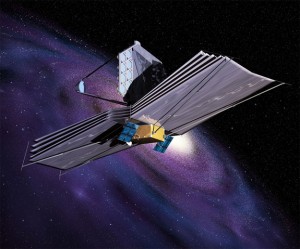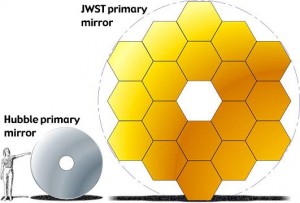The James Webb Space Telescope (JWST) is a huge space telescope designed to be the premier observatory in the coming decade. It will study the mysterious infrared universe looking far back in time to see the first ever galaxies to form in the universe.

Here is everything you would want to know about JWST including its cost, launch date, capabilities, how far back in time it will be able to see and how similar or different it is compared to other space observatories such as the Hubble Space Telescope and Herschel Space Observatory.
What Is James Webb Space Telescope and What Is Its History?
Scientists planned to launch a large space telescope that would be known as the Next Generation Space Telescope (NGST). It was later renamed to James Webb Space Telescope in honor of James Webb who was NASA’s chief from 1961-1968. He was very committed to space science and it was in his time that the Apollo program was developed.
James Webb is truly an international effort. The European Agency (ESA) and Canadian Space Agency (CSA) have collaborated with NASA to develop this project. NASA’s Goddard Space Flight Center is in charge of development, ESA and CSA will contribute instruments, and the telescope will be operated by the Space Telescope Science Institute, which also operates Hubble.
James Webb Space Telescope Cost
James Webb is a large and expensive project. Initially, it was estimated to cost about $5 billion but it has exceeded this budget. It is estimated to cost about $8.7 billion making it one of the most ambitious projects by NASA.
James Webb Space Telescope Launch
The first launch date was set in 2014 and the project implementation began in 2008. However, funding constraints and technical issues led to the launch being postponed. NASA is now positive that the telescope will be launched some time in 2018.
It will launch from Arianespace’s ELA-3 launch facility in Kourou, French Guiana on an Ariane 5 rocket. Its sun shield and mirrors are so large that they will be in a folded form during the launch and will only unfold once in space.
James Webb Location in Space
This telescope will occupy a position in space that is about 1.5 million km (1 million miles) from Earth. Rather than orbit with the Earth, it will remain in a fixed position.
Since it will observe mainly infrared light coming from very faint and distant objects, it will need to be highly sensitive to detect faint signals.
Light from the sun, Earth and moon can interfere with its observation. This position is ideal because it is not only stable but will also ensure that the solar shield will block the light coming from the Sun, Earth and Moon.

The James Webb Space Telescope’s Design and Components
The observatory is the part of the James Webb Space Telescope that will be based in space and it has three components.
There is the Integrated Science Instruments Module (ISIM), which houses the telescope’s four science instruments.
Then there is the Optical Telescope Element (OTE), which is composed of the mirrors that will gather light and the backplane supporting the mirrors. One of the most outstanding features of the Webb telescope will be its extremely large mirror that is 6.5 meters in diameter. This will be the largest mirror ever launched into space. The mirror segments are covered with extremely thin layers of gold.
The final component is the spacecraft element composed of the spacecraft and the tennis court sized sunshield that will keep the OTE and ISIM at extremely low temperature as required by infrared telescopes.

James Webb Space Telescope Will Have Amazing Capabilities
The James Webb Space Telescope will be so powerful and sophisticated that it will be able to see through the dust clouds found in the cosmic region to observe newly forming planetary systems and investigate the elements that support life in the solar system.
It is optimized to observe best at infrared wavelengths. Infrared telescopes are suited to observe the early galaxies as their light is shifted to the infrared. It will also have some capability to observe in the visible range.
Its detectors are extremely sensitive and will be able to detect even the weakest of signals from objects in the universe. The James Webb Space Telescope will offer an extremely deep view of the distant universe making it possible to observe parts of the universe that have never been seen before.
The James Webb Space Telescope’s Four Instruments
MIRI
Contributed by the European Consortium in conjunction with ESA and NASA’s Jet Propulsion Laboratory, Mid-InfraRed Instrument (MIRI) will be able to operate at extremely low temperature.
It will detect and capture images of the far away galaxies located at the edges of the universe, newly formed distant planets, distant celestial objects, regions of obscured star formation and Kuiper Belt Objects. It will also detect comets that are too faint to be seen by other telescopes.
MIRI also has a spectrograph that will enable scientists to observe more details of distant objects in the universe.
FGS/NIRISS
From the Canadian Space Agency is the Fine Guidance Sensor/Near InfraRed Imager and Slitless Spectrograph (FGS/NIRISS) that will take extremely detailed and high quality images of other bodies in space.
This is actually two instruments in one. FGS will ensure the telescope faces the right direction so it can make the required observation and take pictures. NIRISS will observe the cosmos looking for signals of the first light in the universe as well as investigate alien planets and their characteristics.
NIRCam
The Near InfraRed Camera (NIRCam) is from the University of Arizona. It will detect light from stars in nearby galaxies including those located within the Milky Way. It will also seek light from stars and galaxies that were the first to form in the universe
NIRSpec
The near InfraRed Spectrograph (NIRSpec) is provided by the European Space Agency and NASA through the Goddard Space Flight Center. It will observe 100s of objects at the same time in search of galaxies that formed immediately after the Big Bang.
How Far Will The James Webb Telescope Be Able To See?
Webb will be detecting light that has taken time to travel from its source. Because it will be observing extremely far away objects, it will be looking far back in time, as early as the Big Bang.
Among Other Things, the James Webb Space Telescope Will Observe the First Galaxies to Form
The James Webb Space Telescope’s main science themes include the End of the Dark Ages, Assembly of galaxies, birth of stars and protoplanetary systems, formation of planetary systems and the origin of life.
It is designed to study every phase in the history of the universe from the Big Bang to the formation of other planetary systems where life can thrive, investigate how the galaxies evolved and even explore how our solar system came to be what it is today.
James Webb will study the first galaxies to form. It will investigate the oldest galaxies that formed at the beginning of the universe just after the Big Bang. It will also study the distant universe looking for stars that were the first to form in the early universe.
It will see beyond the dusty clouds to observe stars forming planetary systems. It will capture infrared images of the distant galaxies exploring signs left behind after the Big Bang. It will seek to uncover the mysteries surrounding the Big Bang.
Just like Hubble, it will also capture images of celestial objects.
James Webb Space Telescope Vs the Hubble Space Telescope
So what is the difference between the James Webb Space Telescope and the Hubble Space Telescope?
Hubble is currently in operation and is expected to complete its mission in2014. James Webb will succeed it and Webb’s mission objectives are based on Hubble’s findings. However, Webb is not similar to Hubble. There are plenty of differences between these two.
Webb will be three times the size of Hubble. Webb’s mirror is larger and more powerful than that of Hubble. Webb’s camera has a larger field of view that collects more light and has the capability to see farther back in time.
Hubble observed at the optical and ultraviolet wavelengths and only had a little infrared capability while Webb will observe at the infrared wavelength with a little capability to observe at the visible wavelength.
Because it has infrared capabilities, Webb will observe extremely distant objects that Hubble lacked the capability to see. It will be able to see farther into the universe. Where Hubble observed toddler galaxies, Webb will see baby galaxies.
Another difference is in the position of the two telescopes in space. Hubble is in orbit closer to Earth. Webb will not even orbit the Earth. It will stay fixed at one position, which is farther away from the Earth than Hubble is.
Hubble was launched into orbit and serviced several times by space shuttles. It is the only telescope serviced in space by astronauts. Since Webb will not be in orbit, it will be launched on an Ariane 5 rocket.
James Webb Space Telescope Vs Herschel Space Observatory
Webb is most similar to ESA’s Herschel Space Observatory in that both are infrared telescopes and will be located at the same position. However, Webb is larger and its camera has a larger mirror.
In addition, each of these telescopes observes in a different wavelength range. Webb will look for the first galaxies that formed in the early universe and it has to be extremely sensitive to observe in the near-IR. Herschel, on the other hand, observes the most actively star-forming galaxies in the far-IR.
